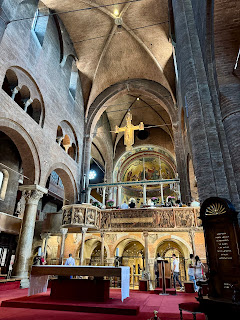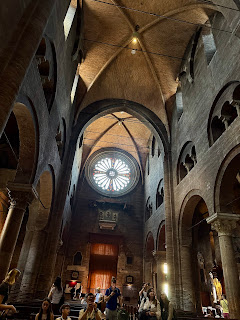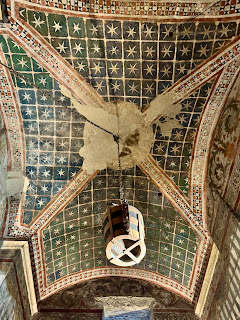We plan two tours in Modena (pop 184,739 in 2025) and before we depart, we learn that our tour of the Palazzo Comunale is cancelled. It's a disappointment, but trust there is plenty to fill our day. The Stazione di Modena (19th century) north of the historic center. We walk out of the station parking area and keep left onto the Corso Vitorio Emanuele Secondo. This is a broad, even, tree-lined boulevard that takes us into the heart of the old town.
Already, Modena feels more peaceful than Bologna (which feels more peaceful than Firenze). We follow the Corso to the back of the Palazzo Ducal (17th century). Walking around the Palazzo to the west, we see the Chiesa di San Domenico (18th century) on our right and the Piazza Roma on our left. In the center of the Piazza is the Monumento a Ciro Menotti, near the layered, formidable front facciata of the Palazzo.
At the end of a long alley, we pass through a small archway and into the Piazza della Torre. The Monumento a Alessandro Tassoni is in the center of the Piazza. Tassoni is the author of a "Poëma Eroicomico" called "La Secchia Rapita" (published 1622). The Torre Ghirlandina (Torre Civica, 12-15th centuries) rises behind the poet's statue, and the secchia (bucket) is inside the Torre:
Vorrei cantar quel memorando sdegnoCh'infiammò già ne' feri petti umani,Un infelice, e vil secchia di legnoChe tolsero a i Petroni i Gemignani;Febo che mi raggiri entro lo'ngegnoL'orribil guerra, e gli accidenti straniTu che sai poëtar seruimi d'Aio,E tiemmi per le maniche del saio.[How fierce a Flame did Italy o'er-run,From a vile Bucket's woodden Cause begun;How the Bolinias and Modenians rag'd,And foreign Aid and distant realms engag'd;How Gallantly they fought, how Bravely Fell,The Bard in num'rous Verse delights to Tell.Thou, Phœbus, who within my Brain do'st roulThe horrid War, and rack'st my lab'ring Soul!Thou who do'st over Harmony preside,O lead me by the Sleeve, and be the Blindman's Guide!](Alessandro Tassoni, La Secchia Rapita, Canto I, I, trans John Ozell, 1713)
The Piazzetta delle Ova is by the east side of the Torre Ghirlandina. The Torre dell’Orologio (15th-16th centuries) and the Palazzo Comunale (16th-19 centuries) stand opposite the apse shading a small market area from the morning sun.
Turning the corner, the Piazzetta delle Ova occupies the northeast of the Piazza Grande. From here, we see the Duomo di Modena (12th-14th centiries) stretching to the west and consider the many iron staples binding the stone blocks of the Torre Ghirlandina.
The archaic, grinning figure of "La Bonissima" (13th century) is affixed to the south corner of the Palazzo, keeping watch over the many shops and restaurants just coming to life.
Past La Bonissima, the morning's setup spills into the Piazza XX Settembre. And further south, the activity seems to emanate from the Mercato Albinelli (20th century), a compact but beautifully organized collection of well-established stalls. The food in Emilia-Romagna certainly shows well.
The neighborhood near the Mercato includes the Chiesa di San Bartolomeo (17th century). The buildings are as vibrant and well-presented as the market stalls. They look so clean, and the colors are incredibly intense, with pale olive-greens and flowery yellows that Bologna lacks.
We have time before lunch to visit the Duomo di Modena (12th-14th centiries). The Porta Regia (13th century) on the southern facade is the entrance from the Piazza Grande, with its deep Romanesque archivolts. The Duomo is dedicated to Santa Maria Assunta e San Geminiano, Modena's fourth-century bishop and patron saint. We assume he's the dark figure protected by the netting in the upper loggia, next to the whale's rib (as we saw in Verona).
Worn frescos remain in the small arches above the outdoor pulpit. Grotesques and other carvings hide in the capitals and the gables ends.
The four-panel relief depicts scenes from San Geminiano's life and his service to Modena (Agostino di Duccio, 1442).
Our close inspection of the Porta Regia reveals crisp carvings and a different colored stone (red Veronese marble); they must be restorations. At the top is a lion with the Cross, and the Duomo's famous Roman leoni stilofori are at the base of the columns on either side of the door. Lions also adorn the lintel of the doorway and seem to be an older vintage compared to the archivolts.
The interior is dim and warm, with four vaulted bays of paired arches to the elevated chancel, with a triple-arched triforium and a small clerestory window for each arch.
A large Crocifissione (wood, 13th century, top image) hangs above the chancel and the words:
Iesus Christus heri et hodie ipse et in saecula[Jesus Christ is the same yesterday and today and forever]
The chancel rail is made from stone panels with scenes from the Settimana Santa (holy week, from left to right): La Lavanda dei Piedi, L'Ultima Cena, Il Bacio di Giuda, La Cattura di Cristo e Il Giudizio di Pilato, Il Cireneo che Porta la Croce. At the left (Evangelist side), Il Pontile Campionese, with the symbols of the Quattro Evangelisti (angel and winged lion, Christ enthroned, eagle and ox), completes the fascia.
The Cappella Laterale on the Epistle side features a half-dome, gold-painted image with the Crocifissione surrounded by spiral, vegetal motifs. Above, the Manus Dei emerges from the opening of the deep blue bunting with a Greek or Templar Cross. Below, a frieze of twelve sheep (representing the Apostles) with the Agnus Dei at the center, finishes the dome.
The female saint in the side arch of the window may be Santa Maria Assunta.
The half dome directly behind the altar is the Duomo's Abside Centrale. It shows Maria Regina with Christ holding an open book "VENI CORONARIS" (come, crown me). Another Manus Dei is in the bunting, this in painted gold tones. S Petrus (Evangelist) and S Paulus (Epistle) witness the coronation.
Below, the Quattro Evangelisti: S Marcus, S Matheus , S Iohanes, and S Lucas are in the piers between the wonderfully decorated windows, with Isaias (Evangelist) and Jerimias (Epistle) in the side arch panels.
A polittico (polyptych) is in the Cappella Laterale on the Evangelist side, a Gothic altarpiece by Serafino de Serafini (14th century). The central image is L'Incoronazione della Vergine and on either side are Santi Nicola e Cristoforo and Geminiano ed Antonio Abate. Above, La Crocefissione is in the center triangular frame, and in the end panels, L'Annunciazione (Gabriele and Maria).
Cristo con i Dodici Apostoli appears in the predella, over an elaborate stone sepolcro (9th century).
We turn and look toward the front of the Duomo from the Il Pontile dei Maestri Campionesi. The dusky bulk of the unadorned and un-plastered masonry glow with sparkling pockets of intense ornament. The art and architecture, the filtered light, the shapes and shadows are enchanting.
La Cripta (11th-12th centuries) in built below the chancel and accessible through the three-bay arcade just under the Settimana Santa panels. Strangely, as we we enter, the lighting brightens and the chamber shimmers with pattern and detail. The column capitals near the steps are medieval, with figures and organic forms, but ones deeper are in classical, fluted Composite order.
The left-hand cappella shows the architecture to best advantage – the chunky masonry vaulting and the fantastic alabaster glazing. The hand-made, heart-shaped, candleholders on the altar are stunners. The right-hand cappella is home to the Presepe (crib, 'Madonna della Pappa', Guido Mazzoni, 1480), a group of large, painted, terracotta figures, including a fantesca (servant) blowing to cool the Child's spoon.
In the center is Il Sepolcro di San Geminiano (4th century Bishop & Patron of Modena, 18th century); we can see his name on the edge of the Sepolcro. Two figures wearing vestments hold an eternal flame over a miniature model of the Duomo.
There are delightful details everywhere. For example, at the base of the semi-circular Pontile Campionese (pier) are the telamone, contorted forms crushed by the weight from the columns.
Il Pulpito di Enrico da Campione (1322) is wrapped around the main pier nearest the Evangelist side of the Cripta.
La Navata Meridionale (south aisle) holds an aging fresco, Il Giudizio Universale (Cristophoro da Lendinara, 15th century). In the tympanum, Cristo floats in a red mandorla, while San Michele and the trumpeters of the Apocalisse descend from the sky to judge those on Earth. The Nascita di Gedù is in the shallower, uppermost tympanum, and the Annunciazione is in the two spandrel panels.
La Navata Settentrionale (north aisle) contains a beautiful gold-faced sepolcro, with the Altare delle Statuine (Michele di Niccolò Dini, 15th century), an amazing terracotta polyptych. The Altare consists of a pair of stacked, five-bay triumphal arches with Gothic finials. The Quattro Evangelisti on either side of La Crocifissione are in the upper register. In the lower register, San Giovanni Battista (camel hair robe) is to the far right of Madonna col Bambino, and on Her left are San Pietro (keys) and Santo Stefano (stones).
The facciata of the Duomo is a more consistently Romanesque design, though interrupted by the Gothic rose window. Below the rose, a vaulted loggia and portico are framed by thin columns with classically derived column capitals, which all rest on another pair of leoni stilofori.
Two panels over the side portals and the two on either side of the central portico make up the "Bassorilievo di Wiligelmo" (Wiligelmo, late 11th-early 12th century). The Bassorilievo tells the Storie della Genesi (Genesis):
La Creazione dell'Uomo, della Donna, e Peccato Originale (north portal),Cacciata dal Paradiso Terrestre (central portico, left)Caino e Abele (central portico, right)Uccisione di Caino e Storie di Noè (south portal)
Turning north, we pass the Chiesa del Voto (17th century), a stout, brick building with a tall dome.
The Porta della Pescheria (Scuola di Wiligelmo, 12th century) is on the north side of the Duomo. In the carved archivolt are scenes from the Legend of Arthur, with inscriptions identifying the knights, such as Isdernus, and Artus de Bretania. Whimsical animal carvings lay across the lintel, with leafy swirls on the abutments. A pair of telamone form the bases on each side and another pair of leoni stilofori carry the archway.
In the far corner, near the buttress spanning to the Torre Ghirlandina, is another fresco fragment.
After lunch, we arrive just before our reservation time to enter the Torre Ghirlandina; so, first a quick walk around. The yearbook-style photos of the Sacrario Partigiano della Ghirlandina are like the Sacrario dei Caduti della Resistenza in Bologna. The portraits, printed on porcelain tiles, appear to be newer and clearer.
Underneath the Sacrario, poignantly pinned near colors of both Palestinian and Italian states, is recent news from past wars – a printed article about twelve-thousand Palestinians fighting with the Allies and Jewish volunteers during World War II.
Tassoni's Monumento is in front of the Sacrario, and his "La Secchia Rapita" continues:
E tu progenie indomita, e feroceDel generoso Catlo ultimo figlio,Ch'oue giri col Padre il guardo attroceMuoui ne'regni altrui guerra, & periglio,Al nuouo suon de l'inudita voceVolgi prego da l'armi, & placa il ciglio,Che vedrai, s'al mio dir porgi l'orecchia,Elena trasformarsi in una Secchia.[ And Thou, the Hope of the World's potent Head,The latest Fruit of Generous Charles's Bed;Thou whose smooth Cheeks and flaxen Locks concealWisdom profound and Thoughts of Public Weal;If haply Thou unknit thy studious Brow,And to thy pondering Breast some Ease allow;If midst thy crouding Cares the Muse find room,Fair Helen shall a Bucket's Form assume.](Alessandro Tassoni, La Secchia Rapita, Canto I, II, trans John Ozell, 1713)
Finally, after ascending a brief stairway, in the first chamber inside the Torre Ghirlandina, we meet the secchia rapita (stolen bucket). This is the Sala della Secchia Rapita. enlivened with patterned frescos from the fifteenth century. The windows are precisely arranged to spotlight the secchia, clearly an object of pride for the Modenese, but at the same time, in the light of Tassoni's 'poëma eroicomico', a testimonial to the folly of war.
The Sala degli Strumenti di Scientifici occupies the bottom landing of the enormous stair tower and is home to a set of devices that primarily checks the integrity of the Torre (think of Bologna). Compared to our ascents in other towers, this one is a piece of cake.
However, we are only able to reach the Stanza dei Torresani (tower guards) about halfway up; unfortunately, the octagonal cuspide (tented roof) is inaccessible. Also, the views from the openings in the Stanza are obscured by heavy wire barriers. The only concession, the center grates on each side have an iPhone-sized opening, so we wait our turn and snap our pictures.
Just after midday, and the roofs of Modena at fully illuminated. Our first view is west, over the Duomo and the Chiesa del Voto. Then south, we get an oblique view of the Torre dell’Orologio and the Palazzo Comunale, as well as over the Piazza Grande and the top of the Porta Regia.
While waiting between views, we notice the extraordinary capitals between the trifori. The "Capitello di Davide" (east trifore) and the "Capitello dei Giudici" (judges, south trifore) tell their concise stories: the crowned figure playing the harp is King David, while the Giudici illustrate good and bad examples of judgement (including the corrupting power of money).
The view east includes the Piazza Giuseppe Mazzini and the Piazzetta delle Ova. Finally, the view of the torresani is to the north; the guards keep an eye on the Palazzo Ducal.
The west capitello provides a finale for the parade of leoni. How unusual to see two bodies on different faces of the capitello merge into a single head posed outward like classical volutes. Freed from their column bases to the capitals, these are lithe, non-weight-bearing lions.
We wind down our tour with gelato in the Piazza Giuseppe Mazzini. With a parked military vehicle, soldiers guard the Piazza. Looking up to the classical temple fronting the Piazza, we note the Hebraic script and realize this is the Temple (Comunità Ebraica), and the true reason for the soldiers (we also saw soldiers by the Sinagoga di Bologna). The folly of war lives on.
We return to the Palazzo Ducal (17th century) with the afternoon light raking the facade.
The Chiesa di San Giorgio (17th century) is nearby, and we make a stop. The exterior is an enjoyable, but messy Baroque classicism in the now-familiar warm tones of Modena. The interior is an octagonal, centralize plan, with fascinating corner transitions: layers of folded pilasters and Corinthian columns creating open loggias.
Two extra images from our walk to the train station help us reflect on our trip. A nautilus shell embedded in the travertine pavement looks like a volute from a column capital and is a reminder of classical orders and lions.
The Tempio Monumentale di San Giuseppe ai Caduti in Guerra (20th century) is southeast of the stazione. The Tempio's crypt memorializes over seven thousand lost during the first World War, the caduti.
Modena's memories are manifest. The art and architecture immortalize the fallen and touchingly contemplate their purpose. They describe the fine line separating valor and futility, or in poetic terms, the difference between a goddess' honor or a neighbor's bucket.

























































































































No comments:
Post a Comment